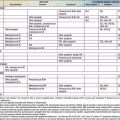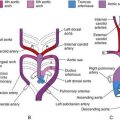Chapter 122 Monocytes, Macrophages, and Dendritic Cells
Mononuclear phagocytes (monocytes, macrophages) are distributed across all body tissues and play a central role in maintaining homeostasis. They are essential for innate host defense against infection, tissue repair and remodeling, and the antigen-specific adaptive immune response. No human has been identified as having congenital absence of this cell line, probably because macrophages are required to remove primitive tissues during fetal development as new tissues develop to replace them. Monocytes and tissue macrophages in their various forms (see Table 122-1 on the Nelson Textbook of Pediatrics website![]() at www.expertconsult.com) constitute the mononuclear phagocyte system. These cells are a system because of their location, common origin, similar morphology, shared surface markers, and common functions, particularly phagocytosis. Conventional dendritic cells are specialized derivatives of this system that develop from a common monocyte-dendritic cell precursor.
at www.expertconsult.com) constitute the mononuclear phagocyte system. These cells are a system because of their location, common origin, similar morphology, shared surface markers, and common functions, particularly phagocytosis. Conventional dendritic cells are specialized derivatives of this system that develop from a common monocyte-dendritic cell precursor.
Development
Monocytes, the circulating precursors of tissue macrophages, develop more rapidly in the bone marrow and remain longer in the circulation than do neutrophils (see Table 121-1). The first recognizable monocyte precursor is the monoblast, followed by the promonocyte, with cytoplasmic granules and an indented nucleus, and, finally, the fully developed monocyte. A mature monocyte is larger than a neutrophil and has cytoplasm filled with granules containing hydrolytic enzymes. The transition from monoblast to mature circulating monocyte requires about 6 days. Monocytes retain a limited capacity to divide, and they undergo considerable further differentiation after entering the tissues, where they may live for weeks to many months.
Among multiple subsets of blood monocytes, 2 major ones can be identified on the basis of surface antigens: CD14++ CD16–, originally termed “classical monocytes” because they constitute 90-95% of total monocytes, and the more mature CD14+ CD16+ “proinflammatory” monocytes, which produce more proinflammatory tumor necrosis factor-α (TNF-α) and less immunosuppressive IL-10 in response to microbial stimuli. Monocytes of either subset migrate into different tissues in response to localized inflammation or, apparently, randomly in the absence of inflammation. Once in the tissues, monocytes undergo transformation into tissue macrophages with morphologic and functional properties that are characteristic for the tissue in which they reside (see Table 122-1).
Activation
The most important step in the maturation of tissue macrophages is the conversion from a resting to a more functionally active cell, a process driven primarily by certain cytokines and microbial products. Macrophage activation is a generic term, with the functional characteristics of an activated macrophage population varying with the cytokine or other stimulus (microbial, chemical) to which the population has been exposed. Classical activation refers to a response to infection that is driven by specifically activated T-helper 1 (Th1)–type lymphocytes and natural killer cells through their release of interferon-γ (IFN-γ). TNF-α secreted by activated macrophages amplifies their activation, as does bacterial cell wall protein or endotoxin. Alternative activation is driven by T-helper 2 (Th2)–type lymphocytes through release of interleukin (IL)-4 and IL-13, cytokines that regulate antibody responses, allergy, and resistance to parasites. Alternatively activated macrophages may have particular functional advantages, such as in wound healing and immunoregulation. In the traditional context of host defense, the term activated macrophage indicates that the “classically activated” cell has an enhanced capacity to kill microorganisms or tumor cells. These macrophages are larger, with more pseudopods and pronounced ruffling of the plasma membrane, and they exhibit accelerated activity of many functions (Table 122-2). Considering the variety of macrophage activities essential to the maintenance of homeostasis, it seems likely that so-called classically and alternatively activated macrophages are examples of a continuum of physiologic functions expressed by these long-lived cells in response to the specific task at hand.
Table 122-2 UPREGULATED FUNCTIONS IN MACROPHAGES ACTIVATED IN RESPONSE TO INFECTION
H2O2, hydrogen peroxide; IFN, interferon; IL, interleukin; MHC, major histocompatibility complex; O2−, superoxide anion; TNF, tumor necrosis factor.
Functional Activities
Numerous functions are upregulated when the macrophage is activated in response to infection (see Table 122-2). Obviously important are the ingestion and killing of intracellular pathogens such as mycobacteria, Listeria, Leishmania, Toxoplasma, and some fungi; however, splenic and hepatic macrophages also clear extracellular pathogens such as pneumococci from the bloodstream. Killing of the ingested organisms depends heavily on products of the respiratory burst (e.g., hydrogen peroxide) and on nitric oxide, and release of these metabolites is enhanced in activated macrophages.
The heightened capacity of activated macrophages to synthesize and release various hydrolytic enzymes and potentially microbicidal materials (see Table 122-2) probably plays a part in their increased killing capacity, although not every macrophage product is secreted in increased amounts when the cell is activated. The macrophage is an extraordinarily active secretory cell. It has been shown to secrete over 100 distinct substances, including cytokines, growth factors, and sterol hormones, placing it in a class with the hepatocyte. Because of the profound effect of some of these secretory products on other cells and the large number and widespread distribution of macrophages, the mononuclear phagocyte system can be viewed as an important endocrine organ. IL-1 illustrates this point well. Microbes and microbial products, burns, ischemia-reperfusion, and other causes of inflammation or tissue damage stimulate the release of IL-1, mainly by monocytes and macrophages. In turn, IL-1 elicits fever, sleep, and release of IL-6, which induces production of acute phase proteins.
Abnormalities of Monocyte-Macrophage or Dendritic Cell Function
Mononuclear phagocytes, as well as neutrophils, from patients with chronic granulomatous disease (CGD) exhibit a profound defect of phagocytic killing (Chapter 124). The inability of affected macrophages to kill ingested organisms leads to abscess formation and characteristic granulomas at sites of macrophage accumulation beneath the skin and in the liver, lungs, spleen, and lymph nodes. IFN-γ is currently used for preventing infection in patients with CGD and for treating the decreased bone resorption of congenital osteopetrosis, which is caused by decreased function of osteoclasts. Genetic deficiency of the CD11/CD18 complex of membrane adherence glycoproteins (leukocyte adhesion defect-1), which includes a receptor for opsonic complement component 3, results in impaired phagocytosis by monocytes (Chapter 124).
The monocyte-macrophage system is prominently involved in lipid storage diseases called sphingolipidoses (Chapter 80.3). In these conditions, the expression in macrophages of a systemic enzymatic defect permits the accumulation of cell debris that is normally cleared. Resistance to infection can be impaired, at least partly because of impairment in macrophage function. Gaucher disease is the prototype for these disorders. In this condition, the enzyme glucocerebrosidase functions abnormally, thus allowing accumulation of glucocerebroside from cell membranes in Gaucher cells throughout the body. In all locations, the Gaucher cell is an altered macrophage. These patients can be treated with infusions of the normal enzyme modified to expose mannose residues, which bind to mannose receptors on macrophages.
The cytokine IL-12 is a powerful inducer of IFN-γ production by T cells and natural killer cells. Individuals with inherited deficiency in macrophage receptors for IFN-γ or lymphocyte receptors for IL-12, or in IL-12 itself, suffer a severe, profound, and selective susceptibility to infection by nontuberculous mycobacteria such as Mycobacterium avium complex or bacillus Calmette-Guérin (BCG) (Chapter 120). About half of these patients have had disseminated Salmonella infection. These abnormalities are now grouped as defects in the IFN-γ–IL-12 axis.
There are two disorders in which macrophage activation is pathologically excessive. Familial and acquired hemophagocytic lymphohistiocytosis is characterized by uncontrolled activation of T cells and macrophages, with resultant fever, hepatosplenomegaly, lymphadenopathy, pancytopenia, marked elevation of serum proinflammatory cytokines, and macrophage hemophagocytosis (Chapter 501). Up to 5% of children with systemic onset juvenile rheumatoid arthritis develop an acute severe complication termed macrophage activation syndrome, with persistent fever (rather than typical febrile spikes), hepatosplenomegaly, pancytopenia, macrophage hemophagocytosis, and coagulopathy, which can progress to disseminated intravascular coagulation and death if not recognized (Chapter 149). Two genetic autoinflammatory diseases result from dysregulation of the mononuclear phagocyte–produced proinflammatory cytokine IL-1. In neonatal onset multisystem inflammatory disorder (NOMID) monocytes overproduce IL-1. In deficiency of the IL-1-receptor antagonist (DIRA), normal activity levels of IL-1 go unopposed. In both conditions patients present in the 1st few days or weeks of life with pustular or urticarial rash, bony overgrowth, elevated sedimentation rate, and other evidence of systemic inflammation.
The term histiocyte was originally used to describe cells thought to be macrophages in fixed tissue preparations. Histiocytosis X represents a malignancy-like overgrowth of Langerhans-type dendritic cells (Chapter 501). Thus, the term Langerhans cell histiocytosis better describes this disorder, because histiocyte is a histologic term and not cell specific.
Dinarello CA. Interleukin-1-β and the autoinflammatory diseases. N Engl J Med. 2009;360:2467-2470.
Mosser DM, Edwards JP. Exploring the full spectrum of macrophage activation. Nat Rev Immunol. 2008;8:958-969.
Murphy K, Travers P, Walport M, editors. Janeway’s immunobiology, ed 7. Garland Science, New York, 2008, 331-343. 368–372
Steinman RM. Dendritic cells: versatile controllers of the immune system. Nat Med. 2007;10:1155-1159.






